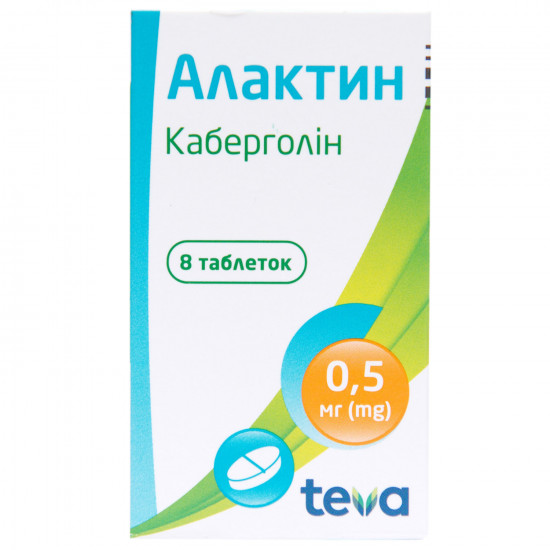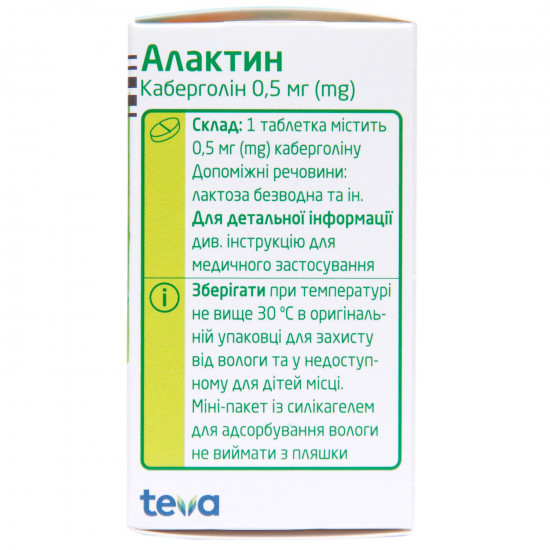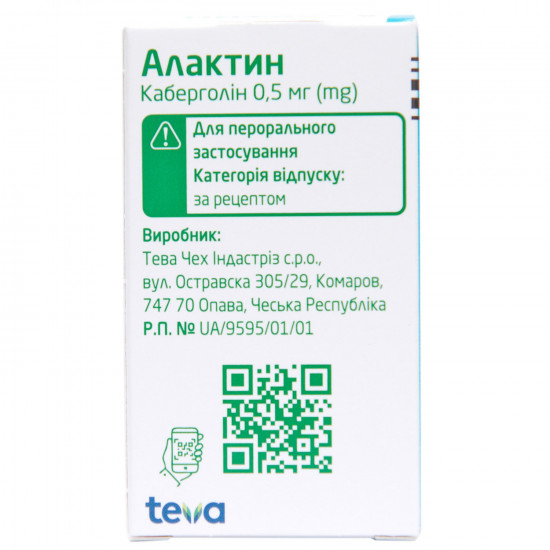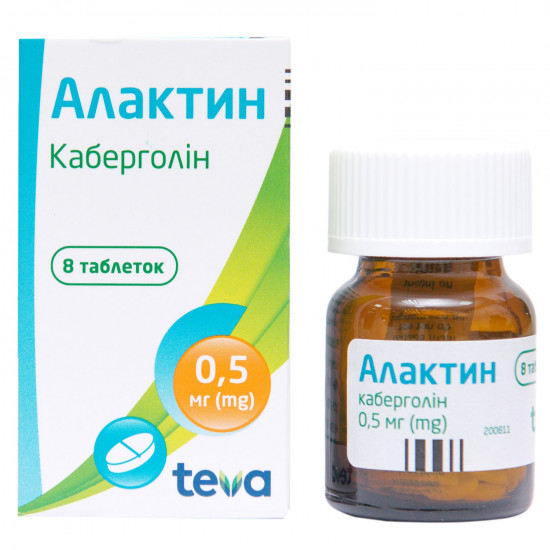







- Stock: In Stock
- Model: 184560
0% Customers recommend this product
-
5 Awesome0%
-
4 Great0%
-
3 Average0%
-
2 Bad0%
-
1 Poor0%
Reviews Over Alaktin of the tab. of 0.5 mg No. 8
- (0)
Total Reviews (0)
click here write review to add review for this product.
Report this review.
Description
Pharmacological properties
Pharmacodynamics. kabergolin — synthetic alkaloid of an ergot and ergolinovy derivative — renders the significant and long prolaktinsnizhayushchy effect.
Prolaktinsnizhayushchy effect is dose-dependent. Decrease in level of prolactin in blood plasma begins in 3 h after administration of medicament Alaktin and remains for 2–3 weeks. The effect of long action means that the single dose is enough to stop stimulation of secretion of milk. At treatment of a giperprolaktinemiya prolactin level in blood plasma is normalized during 2–4 weeks after achievement of an optimum dose. Level of prolactin can decrease still significantly and for several months after the treatment termination.
As for endocrinological effects of a kabergolin, not connected with antiprolaktinemichesky effect, the data obtained in experiments on animals confirm that the studied medicament has selective effect without influence on the main secretion of other hypophyseal hormones or cortisol.
Pharmakodinamichesky action of a kabergolin which does not correlate with therapeutic effect concerns only decrease in the ABP. The maximum hypotensive effect of a single dose of a kabergolin is reached usually for the first 6 h after administration of drug, and the maximum decrease in the ABP and frequency of emergence of such effect are dose-dependent.
Pharmacokinetics. Absorption. Kabergolin is quickly soaked up in a GIT after intake, the C max in blood plasma is reached in 0.5-4 h. Meal does not influence absorption and distribution of a kabergolin.
Distribution. Experiments of in vitro showed what kabergolin in concentration of 0.1-10 ng/ml for 41–42% contacts proteins of blood plasma.
Biotransformation. The main metabolite identified in urine is 6-алил-8β-карбокси-эрголин, making 4–6% of a dose. Three other metabolites make totally 3% of a dose. The activity of metabolites concerning prolactin secretion ingibition investigated by in vitro is much lower than a kabergolin.
Removal. T ½ kabergolina long: Patients have 79–115 h with a giperprolaktinemiya.
In 10 days after administration of medicament about 18 and 72% of a dose it are p in urine and Calais respectively. 2–3% of a dose are defined in urine in not changed look.
Indication
byInhibition/suppression of a physiological lactation
Alaktin is appointed for the purpose of inhibition of a physiological postnatal lactation right after childbirth or for suppression of the lactation which was established in the following cases:
- after the delivery if mother decided not to nurse the child or when feeding by a breast is contraindicated to mother or the child for the medical reasons;
- after the birth of a dead fruit or abortion.
by
for treatment of the disturbances connected with a giperprolaktinemiya including an amenorrhea, an oligomenorrhea, anovulation and a galactorrhoea. Drug is shown for treatment of patients with prolaktinsekretiruyushchy adenomas of a hypophysis (micro and makroprolaktinoma), an idiopathic giperprolaktinemiya or a syndrome of a "empty" Turkish saddle with the accompanying giperprolaktinemiya which are the main morbid conditions causing above-mentioned clinical manifestations.
Use
byAlaktin is appointed inside.
for the purpose of reduction of risk of development of side effects from a GIT is recommended to be accepted kabergolin at meal time.
Inhibition/suppression of a postnatal lactation. Alaktin it is necessary to apply to inhibition of a postnatal lactation for the first 24 h after the delivery. The recommended therapeutic dose — 1 mg of a kabergolin once. For suppression of the existing lactation — 0.25 mg each 12 h within 2 days (the general dose — 1 mg). Such mode of dosing is better transferred by women who decided to suppress a lactation, than reception in the form of a single dose, and it is followed by the smaller frequency of emergence of the undesirable phenomena, especially AG symptoms.
Treatment of giperprolaktinemichesky states. The recommended initial dose of the medicament Alaktin makes 0.5 mg once a week or ½ tablets on 0.5 mg 2 times a week (for example on Monday and Thursday). If necessary it is possible to increase gradually a dose under observation of the doctor — by 0.5 mg/week with a monthly interval before achievement of therapeutic effect. Usually therapeutic dose makes 1 mg/week and can fluctuate from 0.25 to 2 mg/week
Maximum dose not has to exceed 3 mg/days
can appoint the Week dose of medicament once or to distribute on 2 and more inclusion in week depending on shipping.
Distribution of a week dose to several receptions is recommended towhen the week dose makes 1 mg.
patients have to be examined byAt selection of a dose for the purpose of definition of the minimum effective therapeutic dose. Normalization of level of prolactin is usually observed during 2–4 weeks of treatment.
After cancellation of a kabergolin usually celebrate a giperprolaktinemiya recurrence.
Patients of advanced age. Experience of use of a kabergolin for elderly people with a giperprolaktinemiya is limited.
Available data confirm lack of extra risk.
Dose decline or termination of treatment. It is necessary to consider expediency of a dose decline or the termination of treatment in the presence at patients:
- drowsiness or cases of sudden backfilling;
- an abnormal liver function.
Contraindication
Hypersensitivity to a kabergolin, other alkaloids of an ergot or any component of drug.
Existence in the anamnesis of a fibrous disease of lungs, pericardium and retroperitoneal space.
Liver failure and toxaemia of pregnant women.
Simultaneous use of antipsychotic medicines.
For long-term treatment: signs of defeat of valves of heart which define with the help ekhokg prior to treatment.
Poslerodovaya AG or uncontrollable AG.
Preeclampsia, eclampsia.
Psychosis in the anamnesis or risk of developing postnatal psychosis.
Side effects
Dose-dependent and their expressiveness can decrease at a gradual dose decline.
At patients with the known intolerance of dopaminergic medicaments the probability of emergence of the undesirable phenomena can be lowered if to begin treatment kabergoliny with reduced doses, for example 0.25 mg once a week, with the subsequent their gradual increase to achievement of a therapeutic dose. In case of steady or heavy by-effects the temporary dose decline with the subsequent its more gradual increase, for example on 0.25 mg/week each 2 weeks, can improve tolerance of drug.
from the vascular system: arterial hypotension at prolonged use, postural hypotension, a peripheral vasospasm, a syncope, inflows.
from heart: a cardial valvulopatiya (including regurgitation) and the disturbances (pericarditis and a pericardiac exudate) connected with it, a cardiopalmus, stenocardia.
from a musculoskeletal system: spasms of the lower extremities, muscle weakness.
from skin and hypodermic cellulose: skin reactions, including an alopecia, rash, an itching, allergic skin reactions.
from the immune system: reactions of hypersensitivity.
Mental disturbances: depression, aggression, hyper sexuality, pathological azartnost, increase libido, crazy ideas, hallucinations, psychotic disorders.
from nervous system: dizziness, headache, vertigo, paresthesia, syncope, tremor, sudden backfilling, tranzitorny hemianopsia, drowsiness.
from a digestive tract: abdominal pain and epigastriums, dyspepsia, nausea, gastritis, constipation, vomiting.
from a reproductive system: mammary gland pain.
from an organ of sight: disorder of vision.
from a respiratory system: dispnoe, breath disturbance, respiratory insufficiency, nasal bleedings, a pleural exudate, fibrosis (including pulmonary fibrosis), pleural fibrosis, thorax pain.
from a gepatobiliarny system: abnormal liver function.
General disturbances: asthenia, fatigue, Eden, peripheral hypostases.
Laboratory researches: decrease in level of hemoglobin at women with an amenorrhea within 1 month after periods, asymptomatic decrease in the ABP (≥20 mm Hg. — systolic and ≥10 mm Hg. — diastolic) can arise 1 time during the first 3–4 days after the delivery, increase in the KFK level of blood, disturbance of indicators of function of a liver.
Description of separate side reactions
Disturbance of control over motivation: a pathological azartnost, increase in a libido, hyper sexuality, impulsive desire to make purchase, overeating, impulsive consumption of food at use of dopamine agonists, including kabergolin.
byAlso noted the following side reactions: nervousness, a dysmenorrhea, an acne, pain, an arthralgia, rhinitis, dryness in a mouth, diarrhea, an abdominal distension, irritation of a throat, a toothache, the symptoms similar to cold, periorbital hypostasis, peripheral hypostasis, anorexia, insomnia, increase/degrowth of a body, disturbance of concentration of attention, excitement.
Special instructions
General. as well as in case of other alkaloids of an ergot, alaktin it is necessary to apply with care at patients with a serious cardiovascular illness, Reynaud's syndrome, stomach ulcer or gastrointestinal bleedings, serious mental diseases in the anamnesis.
do not havedata on influence of alcohol on shipping of a kabergolin.
Simptomaticheskaya AG can develop at use of a kabergolin at any indication.
Liver failure. At the patients with a heavy liver failure undergoing long therapy kabergoliny it is reasonable to consider a question of use of medicament in reduced doses. Unlike healthy volunteers and persons with a liver failure of smaller degree, at patients with heavy abnormal liver functions (class C on a scale of Chayld-Pyyu) increase in AUC at single dose of medicament in a dose of 1 mg is noted.
Renal failure. The difference in pharmacokinetics of a kabergolin in a disease of kidneys of average and heavy degree is noted. The pharmacokinetics of a kabergolin at patients with an end-stage of a renal failure or at the patients who are on a hemodialysis was not investigated therefore such patients should use medicament with care.
Postural hypotension. During Alaktin's use the postural hypotension was observed. Therefore it is necessary to apply with care it in combination with medicaments which can also lower the arterial blood pressure.
Fibrosis, cardial valvulopatiya and other critical conditions. The fibrous and serous inflammations, such as pleurisy, pleural exudate, pleural fibrosis, pulmonary fibrosis, pericarditis, pericardiac exudate, cardial valvulopatiya striking ≥1 valve (aortal, mitral and tricuspid), or retroperitoneal fibrosis arise after long use of such ergolinovy derivatives with agonistic activity in relation to serotoninovy 5-HT 2B - to receptors as kabergolin. In certain cases the expressiveness of symptoms and clinical manifestations of a cardial valvulopatiya decreases after cancellation of a kabergolin.
byIt is revealed that SOE at a pleural exudate / fibrosis exceeds norm. At increase in SOE to the values exceeding norm carrying out a X-ray analysis of bodies of a thorax is recommended. After cancellation of a kabergolin at establishment of the diagnosis of pleurisy / pulmonary fibrosis it was reported about improvement of a clinical condition of the patient.
Valvulopatiya was noted at use of cumulative doses therefore patients should appoint the lowest effective doses. During each visit to the doctor it is necessary to estimate anew a ratio of advantage and risk for this patient for the purpose of determination of expediency of continuation of treatment kabergoliny.
Prior to long treatment all patients have to undergo inspection of a cardiovascular system, including ekhokg, for definition of presence of an asymptomatic disease of valves. It is also reasonable to carry out definition of basic indicators of the SOE level or other markers of inflammation, pulmonary function (X-ray analysis of bodies of a thorax) and function of kidneys prior to treatment.
Does not know towhether the course of the disease at patients with valve regurgitation can worsen reception of a kabergolin. It is established that in the presence of fibrous changes of valves the patients should not carry out therapy kabergoliny.
during long treatment: as existence of fibrous changes can have the hidden beginning, it is necessary to carry out regular monitoring of probable signs of progressing of fibrosis. Thus, during therapy it is necessary to pay attention to the following symptoms:
- a plevropulmonalny disease — dispnoe, short wind, constant cough or thorax pain;
- a renal failure or obstruction of ureteric/belly vessels which can be shown in the form of pain in a waist/side and hypostasis of the lower extremity and also any formations in an abdominal cavity or morbidity which can indicate presence of retroperitoneal fibrosis;
- heart failure: cases of valve or pericardiac fibrosis are often shown in the form of heart failure. Therefore at emergence of the corresponding symptoms it is necessary to exclude valve fibrosis (and a konstriktorny pericarditis).
Clinical diagnostic monitoring of development of fibrous disturbances is obligatory. The first ekhokg needs to be carried out for 3–6 months after an initiation of treatment; further the frequency of ehoKG-researches should be determined according to individual clinical signs, special attention needs to be paid on above-mentioned symptoms, but monitoring is recommended to spend at least each 6–12 months
Use of a kabergolin should be stopped at identification on ekhokg signs new or deteriorations in the existing valve regurgitation, restriction of the valve or consolidation of shutters of the valve.
Need of carrying out other clinical methods of inspection (for example physical inspection, auscultation of heart, a X-ray analysis, KT-scanning) has to be defined byindividually.
Corresponding additional researches, such as determination of the SOE level and creatinine in blood plasma, carry out in need of confirmation of the diagnosis of fibrous disturbances.
Arterial hypotension. During 6 h after use of a kabergolin the symptomatic hypotension therefore with extra care it is necessary to appoint kabergolin along with other medicines which can lower the arterial blood pressure can develop. Taking into account T ½ hypotensive effect can remain within several days after medicament withdrawal. During the first 3–4 days after the beginning of therapy it is recommended to carry out monitoring with regular measurements of the ABP.
toIt was reported that in researches of a puerperal period noted cases of decrease in the ABP (≥20 mm Hg. — systolic and ≥10 mm Hg — diastolic) in 3–4 days after reception of a kabergolin in a single dose of 1 mg. Undesirable effects usually noted during the first 2 weeks then their manifestations decreased or absolutely disappeared.
Disturbance of control over motives. It is necessary to observe carefully patients regarding emergence of disturbances of control over motives. Patients and their environment should be warned about possible changes in behavior which demonstrate disturbance of control over motives, such as pathological azartnost, increase in a libido, hyper sexuality, impulsive desire to make purchase, overeating, impulsive consumption of food at use of dopamine agonists, including kabergolin. In this case it is necessary to lower a dose or to stop administration of drug.
Inhibition/suppression of a physiological lactation. As well as other alkaloids of an ergot, Alaktin it is necessary to apply at patients from AG caused by pregnancy only in cases when the expected advantage of treatment exceeds risk.
Should avoid single use in a dose of 0.25 mg for women who nurse, in order to avoid development of postural hypotension.
Treatment of a giperprolaktinemiya. The basic reason of a giperprolaktinemiya has to be established prior to treatment kabergoliny as the giperprolaktinemiya which is followed by an amenorrhea/galactorrhoea and infertility can be connected with hypophysis tumors.
At achievement of an effective therapeutic dose control of level of prolactin in blood plasma is recommended to be carried out once a month, normalization of level of prolactin in blood plasma is registered usually for 2–4 weeks
After cancellation of a kabergolin, as a rule, there is a giperprolaktinemiya recurrence. However at some patients the permanent oppression of level of prolactin developed for several months.
should carry out byBefore an initiation of treatment of a giperprolaktinemiya diagnostics of a condition of a hypophysis. Drug restores an ovulation and fertility at women with a giperprolaktinemichesky hypogonadism therefore the test for pregnancy is recommended to spend each 4 weeks during the period of an amenorrhea and every time after restoration of periods if their delay makes more than 3 days. Women who do not plan pregnancy have to apply means of mechanical contraception throughout therapy and after medicament withdrawal before return of anovulation. If pregnancy occurs during treatment, reception of a kabergolin should be stopped. As a precautionary measure it is necessary to carry out observation of women who became pregnant, for identification of signs of increase in a hypophysis as there is a possibility of increase in volume of already existing hypophysis tumor during pregnancy. Before prescribing of medicament it is necessary to exclude pregnancy. Considering limited clinical experience of use of medicament and its long T ½ , as a precautionary measure it is recommended to stop to the women planning pregnancy after achievement of a regular ovulatory cycle use of a kabergolin a month before the expected conception. For the patients taking the medicament it is long, it is recommended to perform regular gynecologic examinations, including cytologic researches of a neck of the uterus and endometrium.
Drowsiness / sudden backfilling. Kabergolin can serve as the drowsiness reason. Agonists of a dopamine can be the cause of sudden backfilling at patients with Parkinson's disease. Above-mentioned information needs to be given patients and to advise to be careful during control of vehicles or work with other automated systems during the treatment period kabergoliny. Patients at whom drowsiness and/or episodes of sudden backfilling are noted should abstain from control of vehicles or work with other automated systems. For such patients it is necessary to consider expediency of a dose decline or the termination of treatment.
Other. This medicine contains lactose. Patients with hereditary intolerance of a galactose, deficiency of lactase or malabsorption of glucose galactose should not use this drug.
Period of pregnancy and feeding by a breast. Pregnancy. Adequate and well controlled researches of use of a kabergolin for pregnant women were not conducted. Researches on animals showed lack of teratogenic effect, however was reported about decrease in fertility and also about embriotoxity, connected with pharmakodinamichesky activity.
toIt was reported about cases of developing of big congenital malformations or the premature termination of pregnancy after therapy kabergoliny pregnant women. Skeletal and muscular pathologies and cardiopulmonary anomalies were the most widespread neonatal anomalies. Information on perinatal disturbances and on further development of babies after pre-natal action of a kabergolin is absent. On the available publications, the prevalence of big congenital malformations in the general population is ≥6.9%. Frequency of congenital anomalies varies in different populations. To define precisely whether there is an increased risk, it is impossible.
Should exclude pregnancy before reception of a kabergolin and to avoid pregnancy within not less than 1 month after the end of therapy. As at patients from giperprolaktinemiy T ½ kabergolina makes 79–115 h, after establishment of a regular ovulatory cycle of the woman which are going to become pregnant, have to stop accepting kabergolin in 1 month prior to the planned conception. It will prevent potential impact of means on a fruit and will not interfere with a possibility of fertilization as in certain cases the ovulatory cycle remains within 6 months after medicament withdrawal. If fertilization happened during treatment, it is necessary to stop therapy after confirmation of pregnancy for the purpose of restriction of influence of medicine for a fruit.
After cancellation of a kabergolin needs to use contraceptives during not less than 4 weeks
Kabergolin restores an ovulation and fertility at women with a giperprolaktinemichesky hypogonadism: as pregnancy can occur before restoration of a menstrual cycle, it is recommended to carry out the test for pregnancy during the amenoreyny period after the periods renewed — every time when the periods are postponed more than for 3 days. Women who do not plan pregnancy are recommended to apply effective non-hormonal contraceptives during treatment and after cancellation of a kabergolin.
and limited data on safety of influence of a kabergolin on a fruit to women who plan pregnancy fertilization is recommended toIn view of long T ½ at least in 1 month after the termination of reception of a kabergolin. After approach of pregnancy of the woman have to be under observation for the purpose of identification of signs of increase in a hypophysis as during pregnancy growth of the existing hypophysis tumors can be noted.
Feeding by a breast. Because of ability to suppress a lactation kabergolin it is impossible to apply at women with giperprolaktinemichesky disturbances which want to nurse.
Kabergolin and/or his metabolites were allocated toin milk at a research on rats. There is no information on discharge in breast milk of the person; however women should not recommend to nurse in case of inefficiency of suppression of a lactation by means of a kabergolin.
Children. Safety and efficiency of medicament did not investigate at children aged 16 years are younger.
Ability to influence speed of response at control of vehicles or work with other mechanisms. In the first days of reception of a kabergolin of patients it is necessary to warn against participation in the activity demanding fast and exact reactions.
to Patients who are treated kabergoliny and at whom drowsiness and/or sudden episodes of backfilling are noted is recommended to refrain from control of vehicles and the activity requiring special attention, so far such episodes and drowsiness will not disappear.
Interaction
Despite the absence of data on interaction of an alaktin with other alkaloids of an ergot, the accompanying therapy by these medicaments throughout long time is not recommended.
As Alaktin implements the effect by direct stimulation of dopamine receptors, simultaneous use of antagonists of a dopamine (for example fenotiazin, phenyl propyl ketones, thioxanthenes, Metoclopramidum) is not recommended not to reduce clinical effect of use of drug.
should not use Drug with makrolidny antibiotics (erythromycin) in connection with increase in system bioavailability of a kabergolin.
needs to consider Alaktin's interaction with other medicaments lowering the arterial blood pressure.
OverdoseAt accidental administration of medicament in very high doses the development of nausea, vomiting, gastric disorders, arterial hypotension, consciousness disturbance (psychosis, hallucinations) is possible
. in similar cases the rendering emergency medical service is necessary.
in case of overdose should take general measures concerning removal of medicament which was not soaked up yet, and if necessary — on maintenance of the ABP. Besides, it is possible to recommend appointment of antagonists of a dopamine (for example a domperidona, Metoclopramidum).
Storage conditions
In original packing for protection against moisture at a temperature not above 30 °C. not to take out a mini-package of silica gel for adsorption of moisture from a bottle.
Specifications
| Characteristics | |
| Active ingredients | Kabergolin |
| Amount of active ingredient | 0.5 mg |
| Applicant | Teva |
| Code of automatic telephone exchange | G02CB03 Kabergolin |
| Interaction with food | In time |
| Light sensitivity | Not sensitive |
| Market status | The branded generic |
| Origin | Chemical |
| Prescription status | According to the prescription |
| Primary packing | bottle |
| Producer | TEVA CECH INDUSTRIES OF NEUTER OF THE LAKE. |
| Quantity in packing | 8 tablets |
| Release form | tablets for internal use |
| Route of administration | Oral |
| Sign | Import |
| Storage temperature | from 5 °C to 30 °C |
| Trade name | Alaktin |














































